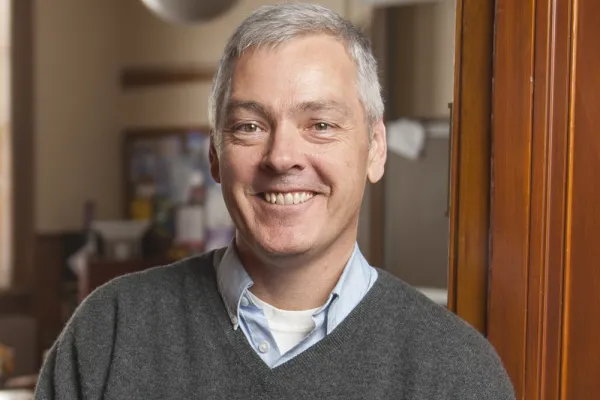Talking with Provost Michael Thurston
News of Note

Published June 28, 2019
In his new role as provost and dean of the faculty, Michael Thurston says he hopes to be an advocate for “a vision of liberal education where people develop their capacities through exploring their passions.”
Thurston—who began work as provost July 1—says he wants to “engage people across the college” in helping Smith continue to inspire and support such exploration.
“We want this to be a place where we can make mistakes, try new things and be challenged,” Thurston says. “That’s the true value of higher education.”
Smith’s Helen Means Professor of English Language and Literature, Thurston has been a member of the college faculty since 2000. A scholar of 20th-century English poetry, he is a published author—including a just-released first novel, “Houses from Another Street.”
While packing up his book-lined office in Seelye for the move to College Hall, Thurston shared these thoughts about his work at Smith.
What are you looking forward to most about being provost?
“I’ve been at Smith for 20 years, and I love the place. I’m looking forward to jumping in and doing things to help strengthen work that’s in progress here. Like the construction of a new Neilson Library. Imagine what that space is going to mean for us! We are also going into a Year on Climate Change, where we’ll be exploring a pressing, existential problem, making it the focus of our attention.”
What are your other priorities for the near future?
“I want to lead a conversation about what a liberal arts education needs to be, and what our faculty needs in order to deliver that. We’ve created a study group on reimagining our curriculum that will help frame that conversation. In the broader world, liberal education is at a moment of reimagining—and that’s a good thing!
“I come into this role knowing that our faculty is a central valued resource, and I’m going to be looking for ways to help my colleagues. What unites us is a real commitment to modes of attention. My colleagues in the sciences are paying attention by looking at atoms; I pay attention by looking at metaphors. We’re doing the same thing.”
You were the first in your family to go to college. What about that experience do you bring to your work at Smith?
“I understood college as the way to a better job. But what I fell in love with was not connected to immediate employment. My first year in college, I literally felt the top of my head growing bigger—like those time-lapse photos of seeds growing. There is a thrill in intellectual engagement and thinking that I want all students to be able to experience.”
A lot has changed since you first came to Smith. What’s something that has stayed the same?
“The quality of our students. There’s a level of motivation and engagement here that’s different from other places. As a women’s college, there is a process of self-selection that plays a role. I continue to think it’s important to have places set aside to empower women.”
What was the inspiration for your first novel, “Houses from Another Street”?
“I’d been publishing short stories for some time and had always thought of myself as a ‘sprinter’ instead of a ‘long-distance runner.’ So it surprised me in 2009 when I started writing a novel. The story sounds autobiographical—it’s set in 1979 and the main character is a 14-year-old boy who lives in what looks like the Dallas/Fort Worth suburbs, where I grew up. But nothing that happens to the character actually happened to me. It’s really about the problems of a certain kind of American masculinity.”
Do you think you’ll keep writing novels?
“I have a draft of another one in a drawer.”